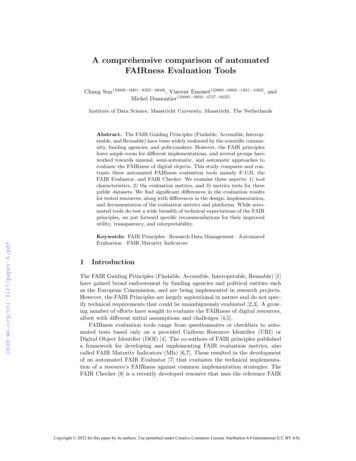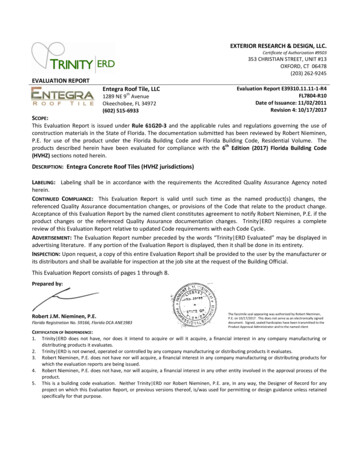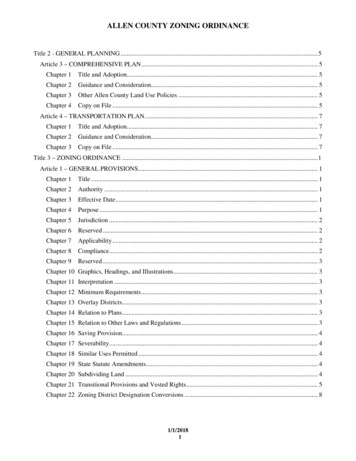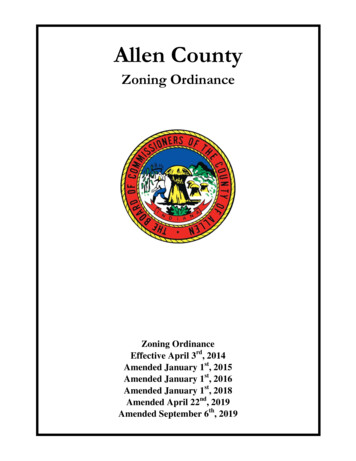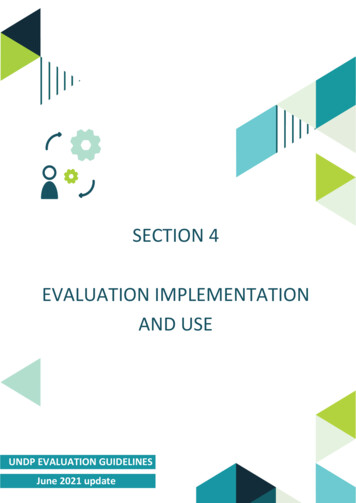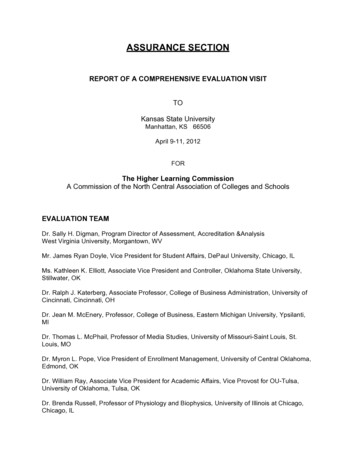
Transcription
ASSURANCE SECTIONREPORT OF A COMPREHENSIVE EVALUATION VISITTOKansas State UniversityManhattan, KS 66506April 9-11, 2012FORThe Higher Learning CommissionA Commission of the North Central Association of Colleges and SchoolsEVALUATION TEAMDr. Sally H. Digman, Program Director of Assessment, Accreditation &AnalysisWest Virginia University, Morgantown, WVMr. James Ryan Doyle, Vice President for Student Affairs, DePaul University, Chicago, ILMs. Kathleen K. Elliott, Associate Vice President and Controller, Oklahoma State University,Stillwater, OKDr. Ralph J. Katerberg, Associate Professor, College of Business Administration, University ofCincinnati, Cincinnati, OHDr. Jean M. McEnery, Professor, College of Business, Eastern Michigan University, Ypsilanti,MIDr. Thomas L. McPhail, Professor of Media Studies, University of Missouri-Saint Louis, St.Louis, MODr. Myron L. Pope, Vice President of Enrollment Management, University of Central Oklahoma,Edmond, OKDr. William Ray, Associate Vice President for Academic Affairs, Vice Provost for OU-Tulsa,University of Oklahoma, Tulsa, OKDr. Brenda Russell, Professor of Physiology and Biophysics, University of Illinois at Chicago,Chicago, IL
Assurance SectionKansas State University/ID# 1289Dr. Gary D. Sandefur, Dean, College of Letters and Science, University of Wisconsin-Madison,Madison, WIDr. Devarajan Venugopalan, Associate Vice Chancellor for Academic Affairs, University ofWisconsin-Milwaukee, Milwaukee, WIDr. Richard A. Hanson (Team Chair), President, Bemidji State University, Bemidji, MN26/20/2012
Assurance SectionKansas State University/ID# 1289ContentsI. Context and Nature of Visit . 4II. Commitment to Peer Review . 7III. Compliance with Federal Requirements . 7IV. Fulfillment of the Criteria. 7a.b.c.d.e.Criterion One . 8Criterion Two . 10Criterion Three . 12Criterion Four . 16Criterion Five . 17V. Affiliation Status . 20VI. Additional Comments and Explanations . 20a. Federal Compliance Worksheet . 21b. Appendix A: Credits and Program Length. 2836/20/2012
Assurance SectionKansas State University/ID# 1289I. CONTEXT AND NATURE OF VISITA. Purpose of VisitThe team evaluated the institution for the purposes of continued accreditation, Federalcompliance, and pathway eligibility.B. Institutional ContextK-State’s main campus is located in Manhattan, amidst the scenic Flint Hills area of Kansas. TheSalina campus, which is home to the College of Technology and Aviation, is locatedapproximately 60 miles west of Manhattan, and the University serves several other locations asindicated in the SAS.The University consists of nine academic colleges: agriculture; architecture, planning and design;arts and sciences; business administration; education; engineering; human ecology; technologyand aviation; and veterinary medicine—in addition to the Graduate School and the Division ofContinuing Education. K-State also includes the vast network of K-State Research and Extensionand Agriculture Experiment Stations providing information and advice to agricultural producersand citizens throughout the state.Since 2002 several leadership changes have occurred. Dr. Kirk Schulz was hired in June 2009 asthe University President, in 2006 Dr. Duane Nellis, was hired as Provost and in January 2010 Dr.April Mason replaced Nellis as provost and senior vice president. Most of the nine colleges, aswell as the Graduate School, the Division of Continuing Education, and the K-State Libraries,have hired new deans since 2002.During 2009-2010 Bruce Shubert was appointed to the position of vice president foradministration and finance, and Jeffery Morris joined K-State in the newly created position of vicepresident for communications and marketing. Ken Stafford was hired as vice provost forinformation technology services/chief information officer. During 2008-2009 Pat Bosco waspromoted to vice president for student life and Ron Trewyn was appointed vice president forresearch. In addition, the Athletics Department has also experienced leadership changes since2002, with John Currie taking the reins as athletic director in May 2009.C. Unique Aspects or Additions to the Visit1. Multi-Campus Visit – Branch Campus in Salina.D. Additional Locations or Branch Campuses Visited (if applicable)None.E. Distance Delivery ReviewedThe institution is authorized to offer up to 20% of its degrees via distance learning. Currently, theinstitution offers 9 bachelor’s degrees, 22 master’s degrees and one PhD degree via distancelearning. That is a total of 32 programs out of a total of 199 degree programs offered by theinstitution for a 16% rate. Currently, the institution has 2300 students (unduplicated count)enrolled in online programs/courses with a large majority pursuing a degree, minor, or acertificate.1. The online programs offered by the institution are appropriate to its mission as a land-grantinstitution. The programs are primarily targeted for Kansas residents for degree completionat the bachelor’s level including 2 2 arrangements with the community colleges. At the46/20/2012
Assurance SectionKansas State University/ID# 1289graduate level, the programs offered are targeted for the professional workforce in the State.The institution also offers a number of online certificates and a minor targeted toward militarypersonnel and working professionals in the state. Also, the institution periodically conducts aneeds assessment among the various constituencies in the State and offers programs thatmeet the needs and matches the capacity of the institution to deliver the programs.2. The development and delivery of the programs including curriculum, pedagogy, andassessment are done by the program faculty in the respective academic units with assistanceprovided by support units including the Division of Continuing Education, technology support,and the library. Course design support is provided within the academic unit as well as fromthe Division of Continuing Education. The courses are taught by program faculty andadjuncts approved by the faculty. The curricula, the learning outcomes and the requirementsfor the online programs are identical to the on-campus offerings of the same programs. Theoversight of the quality of programs rests with the program faculty in the academic units.3. Student admission, advising, and other support services (such as financial aid, accessibilityassistance, and technology assistance) are provided by the academic units responsible forthe programs with assistance from the Division of Continuing Education. Library resourcesprescribed for the courses by faculty are provided electronically to students.4. Student verification is done through a variety of methods including login procedures, use ofproctoring services, and in-person examinations. The distance learning websitecommunicates to students that the cost of using proctoring services will be the responsibilityof the students. The institutional program assessment processes include assessment ofonline learning. Faculty professional development includes academic integrity issuesassociated with online learning.F. Interactions with ConstituenciesPresidentProvostChief Financial OfficerGovernment Relations OfficerStudent SenatorsNE Area Extension DirectorAssoc. Director Res. and ExtensionAssistant Director, FCSAssistant to the Dean, AgDean, Agriculture (interim)Director, International Ag ProgramAsst Director Ag Nat ResourcesAssociate Dean, AgricultureAssoc Dir. Ag ResearchSenior VP for Development, FoundationChief Operating Officer & CFO, FoundationChamber of Commerce (10 members)Academic Deans (nine deans attended)Head, Soc, Anthro & Soc WorkFaculty Senators (eight faculty attended)Assoc Dir., BiologyDir., Ctr. Quant. EducationCo-Chair, Faculty AffairsDir., Writing CenterGeneral Counsel5Assoc. General CounselDir., Affirmative ActionChief Information OfficerAssociate VP Human ResourcesAssociate Director, Human ResourcesGraduate Student Meeting (26 students)Dean, Graduate SchoolAssociate Dean, Graduate SchoolFt. Leavenworth Dir. of Grad. Ed. AndOutreachLiaison to Graduate Council Assessmentand Review CommitteeAsst. VP Student LifeDirector of AdmissionsAssoc. VP for Student LifeSr. Assoc. Dir. Financial AssistanceDir. New Student ServicesAssoc. Dean and Director Student LifeHLC Executive Committee (13 members)Department Heads (40 people)Assoc. VP for Student LifeDir. Academic Assistance CenterAsst/ Director Housing and DiningDir. Alcohol and Drug Education ServiceSenior Assoc. Dean for Student Life6/20/2012
Assurance SectionKansas State University/ID# 1289Coord., Academic/Career Information CntrDirector, PILOTS ProgramCo-Directors K-State First (2 people)Center for Engagement and CommunityDevelopment (six persons, faculty andstaff)Faculty & Staff Open Meeting (60 people)Senior VP Alumni AssociationAssociate VP Alumni AssociationPresident, Alumni AssociationAssessment Committee (12 Fac. & Staff)Online Program Comm. (13 Fac. & Staff)Distance Educ. Comm. (13 Fac. & Staff)Classified Staff Senate (20 Staff)Commun. & Marketing Group (6 Staff)CEO and Dean, Salina CampusSalina Campus Leaders (9 Staff)Women of K-State Advisory Group (24 Fac.& Staff2025 Planning Committee (3 Fac. & Staff)Office of Research (4 Fac. & Staff)Library (5 Staff And Administrators)Military Science (6 Fac. & Staff)K-State 8 Group (Gen Ed) (22 Fac. & Staff)International Programs (7 Staff)International Students Group (10 students)Comm. For Academic Policies &Procedures (17 Fac. & Staff)Information Technology AssistanceCenter/Office of Mediated Education (9Staff)Diversity Group (32 Fac. & Staff)Facilities Director and Staff (6 Staff)Student Open Meeting (13 Students)Master Planning Committee (11 Fac. &Staff)Manhattan Chamber of Commerce (10Community Members)Kansas Board of Regents (6 Regents)Student Foundation (K-State Proud) (9Students)K-State Athletics (2 Senior Assoc. AthleticDirectors)VP Student Affairs – ServicesAssoc. VP, Human ResourcesAssociate Director, Human ServicesSalina Campus Staff & Faculty (24persons)Undergraduate Research Committee (10persons)G. Principal Documents, Materials, and Web Pages ReviewedKSU University HandbookGraduate HandbookGrievance Process HandbookKansas Board of Regents HandbookPerformance Agreement Report for KSUK-State 2025 PlanstK-State First (1 Year Experience)K-State University Organizational ChartK-State University Mission StatementK-State Policy and procedures ManualPolicy on Integrity in Research/ScholarlyActivityProvost Organization ChartStrategic Plan for DiversityStudent Code of ConductMaster Plan UpdateProposed Campaign for KSURegents Performance AgreementsOne and Four-year alumni SurveysAssessment at K-StateAcademic Department Guidelines (T&P)Div. Continuing Education Materials NotebookE-Learning Faculty ModulesK-State Online WebsiteUniversity Honors Program WebsiteK-State 8 (Gen Ed) WebsiteEngagement & Community Develop. WebsiteK-State Annual financial Report 20116K-State Annual financial Report 2010Audit Supplemental Information 2011Audit Supplemental Information, 2010Revenues Pledged and Restricted 2011Revenues Pledged and Restricted 2010Annual Progress Report on Student LearningAssessment by College, 2011KSU Program Review 2011Assessment ProcessesAssessment Showcase WorkshopsDepartment Promotion and Tenure DocsAlumni SurveysCareer and Employment ServicesDepartment Promotion and Tenure GuidelinesDeveloping Scholars ProgramOffice of Disability and Support ServicesFirst Year SeminarsInternational Service TeamsK-State Book NetworkMAP-WorksMcNair Scholars ProgramNSSE Student OutcomesNew Faculty InstitutePeer Review of Teaching ProgramPILOTs ProgramSenior SurveyTilford GroupUniversity Experience6/20/2012
Assurance SectionKansas State University/ID# 1289University Honors ProgramLife CaféWildcat Warm-UpWriting CenterKSU Program Review 2006-2011Annual Progress ReportsLibrary Collections and Financial ReportsII. COMMITMENT TO PEER REVIEWA. Comprehensiveness of the Self-Study ProcessThe team rated the commitment to the self-study process of members of the administration,faculty and staff as good. The comprehensiveness of the process on campus was good.B. Integrity of the Self-Study ReportThe team rated the integrity of the Self-study Report as good, but throughout the visit, teammembers expressed some frustration about access to data. This concern is likely the result of thevirtual nature of the report and the related data sources. The content of the self-study report cameoff as insufficient in more than one instance and it is likely due to the transition in the way the selfstudy and the data are presented.C. Adequacy of Progress in Addressing Previously Identified ChallengesThe team considers the response of the institution to previously identified challenges to beadequate.D. Notification of Evaluation Visit and Solicitation of Third-Party CommentRequirements were fulfilled. The team noted the solicitation of Third Party Comment for theEvaluation Visit. Six responses were received and reviewed by the team.III. COMPLIANCE WITH FEDERAL REQUIREMENTSThe team reviewed the required Title IV compliance areas and the student complaint information.After reviewing the materials created by the University, the Team offers these observations.A. Credit Hours and Program Length - In order to meet the new Commission expectationsrelated to the federally mandated policy on the credit hour, a task force recommendation wasapproved by the Faculty Senate in February of 2012. After reviewing this policy, the teamconcluded this KSU policy equates its learning experiences with semester credit hours usingconsistent, common and observable practices. Also, the team noted the Kansas Board ofRegents established minimum credit hours needed for associate’s(60) and bachelor’s (120)degrees as well as additional requirements for graduate degrees.B. Tuition and Fees – Three colleges (Business Administration; Engineering; and Architecture,Planning, and Design) have an additional per-credit-hour fee. These fees are used for eithermaintaining the competitiveness of faculty salaries or for additional classroom, laboratory, orstudio equipment. The team concluded these differential tuitions were appropriate given HLCstandards.IV. FULFILLMENT OF THE CRITERIAIntegrate evidentiary statements on distance delivery and the extended operations of the institution(campuses, additional locations) in appropriate criterion sections.76/20/2012
Assurance SectionKansas State University/ID# 12891. If the institution provides offerings by distance delivery, include 3-5 discrete evidentiarystatements on the findings in appropriate Criterion sections, referencing appropriate CoreComponents.2. If the evaluation included reviews of branch campuses (Multi-Campus Visit), include 3-5discrete evidentiary statements on the findings related to the extended operations of theinstitution in appropriate Criterion sections, referencing appropriate Core Components.Submit all Multi-Campus reports with this team report, along with the schedule of visits.The evaluation should focus on the quality of the extended operations, policies andprocesses for assuring effective oversight, and policies and processes for evaluating andimproving education across all of the institution’s extended operations.3. Incorporate your findings on distance delivery and extended operations into yourconclusions for each Criterion and your recommendation on the accreditationrelationship.CRITERION ONE: MISSION AND INTEGRITY. The organization operates with integrity toensure the fulfillment of its mission through structures and processes that involve the board,administration, faculty, staff, and students.1. Evidence that Core Components are meta. Kansas State University presents its mission in its bulletins, on the website, and inother public documents that were reviewed by the review team. The mission isappropriate for an institution of higher learning and keeps teaching, research andservice at the core. The institution also made revisions to its Principles ofCommunity in 2010. These principles express some of the central values that shouldguide behavior and communication on the campus. The current version of themission statement was approved by the Board of Regents in 2008. (1a)b. The K-State 2025 plan represents the new administration’s vision for the institution tobecome a top 50 public research University by 2025. This plan was developed withhigh levels of engagement of all internal and external stakeholders. The vision isconsistent with the mission of the university and was found by the team to be widelyunderstood and deeply embraced throughout the institution. The Board of Regentswas found to be enthusiastic in its support of the plan. This vision is now in the earlystages of its implementation, with academic units, student affairs and other elementsof the university developing plans to align their efforts with the K-State 2025 plan.(1a)c. The 2002 team expressed several concerns about diversity. These have beenseriously addressed with increased funding and fundraising for the Office of Diversity,and an increasing number of multicultural programs across the campus. It isnoteworthy that every college has a diversity officer, usually at the assistant deanlevel, who is the point person for diversity in the unit. Further, diversity has been oneof the undergraduate student learning outcomes since 2004. The Tilford Initiative forMulti-Cultural Curriculum Transformation has supported the development ofmulticultural competencies through faculty development grants to encourage facultyto integrate these competencies into their courses. Diversity has also been a priorityin student recruiting, with 36% growth in African American enrollment, and 88%growth in Hispanic enrollment from 2007-2011. For Fall, 2011, 14% of theundergraduate student population were from historically under-represented groups.The university offers a full range of programs to support the success of thesestudents, and many faculty and staff members expressed deep commitment to thesuccess of these students. (1b)d. The K-State 8 goal for Global Issues and Perspectives is designed to provide allgraduates to live and work within a global community throughout their lives. To this86/20/2012
Assurance SectionKansas State University/ID# 1289end K-State has actively engaged in recruitment of international undergraduates nowreaching 1,857 students with nonresident alien status. More than 50 percent of thesestudents are from China where K-State has a recruitment office. There is also arecruitment office in India and more are planned in other non-Asian countries. TheUniversity has a study abroad program that is gaining popularity with students, andbeing supported by an additional advisor on campus. International undergraduatesand graduate students report that they make friends with domestic students throughthe many well-organized campus events, such as the over-subscribed coffee hoursheld in the international center on campus. Additionally friendships are formed byresident dormitory contacts and by classroom team experiences. This focus on theinternational engaged is enriching the Kansas students as well as forming futureconnections worldwide and is deemed to be meeting one aspect of diversity:multiculturalism. (1b)e. Women are underrepresented in academic careers, especially in areas that havedifficulty attracting women, such as STEM (science, technology, engineering, andmath) fields. In 2003 K-State received a 3.5 million ADVANCE InstitutionalTransformation grant from NSF, which funded programs specifically designed toincrease women’s success in academic careers and STEM fields. This program hasawarded funds to faculty in the Colleges of Agriculture, Arts and Sciences,Engineering, Human Ecology, Technology and Aviation, and Veterinary Medicine.These funds have been fully dispersed, but the University has institutionalized theprogram and established the K-State Office for the Advancement of Women inScience and Engineering, which continues to support ADVANCE initiatives such asthe ADVANCE Distinguished Lecture Series, to provide opportunities for femalestudents in junior high and high school to learn about careers in the STEM fields. TheGirls Researching Our World (GROW) program targets 6th to 8th grade girls, and theExploring Science Technology and Engineering (EXCITE!) program targets youngwomen in grades 9 to 12. Although continued support is needed, there is goodevidence that K-State shows serious concern for diversity with respect to women.Both the mission statement and K-State 2025 now embrace diversity, and the teamfound that commitment to diversity was deep and broad in the university. (1b)f. As the most recent expression of the university’s mission, K-State 2025 is clearlyhaving an impact on the institution. Morale is high and has been boosted in largepart by the new leadership of the president and provost, and the clearly statedaspiration to become a Top 50 public research university by 2025. The stakeholderswith whom the team met, from Board of Regents to undergraduate students wereknowledgeable and supportive of the plan, some seeing it as being a long overdueand healthy aspiration for the university. (1c)g. The team met with six of the nine members of the Kansas Board of Regents and wasimpressed with their commitment and dedication to K-State and advocacy with theKansas legislature for support of the mission of the university and the 2025 plan. TheUniversity has regular meetings of organizational groups that are well structured todiscuss mission-related issues and strategies. These include the President’s, thePresident’s Advisory Committee, the Council of Deans, Faculty Senate, Kansas StateUniversity Foundation Board and K-State Alumni Association Board, the StudentSenate and the Classified Senate. The university is well organized and effectivelymanaged to convey the land-grant mission to constituents from the top levels of theuniversity through both traditional and electronic communication. (1c)h. The President, Provost, and other members of Senior Leadership meet monthly withthe Kansas Board of Regents and it is apparent that there is an excellent relationshipand shared understanding of the mission and its implementation. Furthermore, theTeam met with representatives of the internal stakeholders—Faculty Senate, StudentSenate, and Classified Senate— and all voiced strong support for 2025. In particularthe Team was impressed with participation of so many people at K-State and thedevelopmental process. The launch of the 2025 plan is widely adopted throughout KState the comment heard from one group after another was "2025 is our plan". The96/20/2012
Assurance Sectioni.j.Kansas State University/ID# 1289Team recognizes that this plan has many facets and not all will be attained but it isevident that it is helping to match the mission of the University in positive growth andimprovement.(1d)Shared governance on curricular and many academic matters is vested in the FacultySenate. The senate meets monthly with the President, and Provost and is active inoversight of all policies that impact faculty. The Student Government Associationrepresents all students in the university and works with the administration oncontinuous improvement of the student experience. The SGA also plays a key role inany tuition and fee increases for the university. The leadership have recently takenthe lead in recommending any increases to the Board of Regents for Approval. (1d)Through the self-study report and in meetings with faculty and staff, the team learnedof several examples of effective shared governance. These include the broadparticipation in the development of K-State 2025, the decision for increases independent tuition waivers for University employees, and in how the universityimplemented mandated budget cuts for FY 2011 and 2012. All involved multiplestakeholders, provided great transparency, and resulted in acceptable solutions tothese challenges. (1d)2. Evidence that one or more specified Core Components need institutionalattentionNone.3. Evidence that one or more specified Core Components require Commissionfollow-up. (If On Notice, Probation, or Withdrawal is being considered, contact the staffliaison.)None.4. Evidence that one or more specified Core Components are not met and requireCommission follow-up. (On Notice, Probation, or Withdrawal is warranted. Contact thestaff liaison.)None.Recommendation of the TeamCriterion is met; no Commission follow-up recommended.CRITERION TWO: PREPARING FOR THE FUTURE. The organization’s allocation ofresources and its processes for evaluation and planning demonstrate its capacity to fulfill itsmission, improve the quality of its education, and respond to future challenges andopportunities.1.Evidence that Core Components are meta. Evidence of strong, consistent and realistic preparation for K-State’s future can beseen in the strategic planning process which is represented by K-State 2025. Thisthoughtful process resulted in the development and institutional commitment of avision to become a top 50 research institution by 2025. The process also included agood collaborative effort within University community. Under the leadership of thePresident, organizational goals were developed through a collaborative processinvolving campus governance structures and external constituencies. (2a)106/20/2012
Assurance SectionKansas State University/ID# 1289b. Evidence that attention is being paid to demographic shifts is the recognition ofoverall slightly declining Kansas high school graduates. K-State is trying to balancethis with increased recruitment of international students. Recruiting offices arelocated in China, India, and there are plans for one in Viet Nam. Enrollments fromthese countries have increased over 8% in the last three years. Total enrollment hasincreased over each of the last five academic years. (2a)c. K-State was awarded the National Bio and Agro-Defense Facility (NBAF) in 2010 toreplace an aging USDA facility at Plum Island, NY. The lab will handle research ondeadly agricultural pathogens. A recent risk assessment puts the chance of a releasethof deadly animal pathogens at 1/10 of 1 percent. The proposed 2013 federalbudget does not contain funding for the construction of NBAF and calls for theDepartment of Homeland Security to reassess the project, but 10 million is included1to begin the transfer of research on certain swine diseases. (2a)d. While decreased State funding always is cause for concern, K-State’s operatingrevenues have increased 48.69% over the last five years. Increased revenues wereaccomplished in part by increased tuitions. Operating expenses have increased only27.07%. This was accomplished by reducing positions by more than 200, and thedefunding of the Targeted Excellence Program. (2b)e. While Targeted Excellence has been defunded, funding for research has actuallyincreased per the F&A proposal (submitted 3/30/12). (2b)f. Looking to the future, a technically challenged campus just a few years ago is now70% wireless. 2011 funding was increased so that 80% of the general useclassrooms can be equipped with at least basic technology over the next two yearson the Manhattan campus. Currently, 25 classrooms have been upgraded and 25more are on schedule for this year. The Salina campus is totally wireless. Also, thecurrent IT budget has increased 10 million over 2011 and the staff has grown by 74FTE through consolidations across campus. (2b)g. All degree programs within the Regents University System are reviewed on an eightyear cycle through a departmental self-study and recommendation process. Acommon set of data across Regents universities is collected on an annual basis,giving administrators and Regents a statistical overview of each academic program.These include information on student enrollment and graduation, instructional facultyheadcount, faculty workload, the allocation of resources, and more. By 2011 everyprogram had been through one cycle of review and some have undergone thesecond cycle. Since the inception of the KBOR program review process, K-State hasdetermined that 52 programs did not meet the KBOR guidelines. Of these, 28 havebeen discontinued, five have been retained but are being monitored forimprovements, 16 met the KBOR guidelines within the three-year time frame, andthree have currently been recommended for internal review and may be consideredfor discontinuance, merger with another program, or retained but monitored forimprovement over the next three years. (2c)h. The graduate programs are evaluated internally at four years (mid-cycle), andreviewed for the Board of Regents at eight years. The first mid-cycle reviews beganin 2008. The four year cycle provides opportunities to consult and improve programsthat are not meeting KBOR minimum standards for headco
1. Multi-Campus Visit - Branch Campus in Salina. D. Additional Locations or Branch Campuses Visited (if applicable) None. E. Distance Delivery Reviewed The institution is authorized to offer up to 20% of its degrees via distance learning. Currently, the institution offers 9 bachelor's degrees, 22 master's degrees and one PhD degree via .


